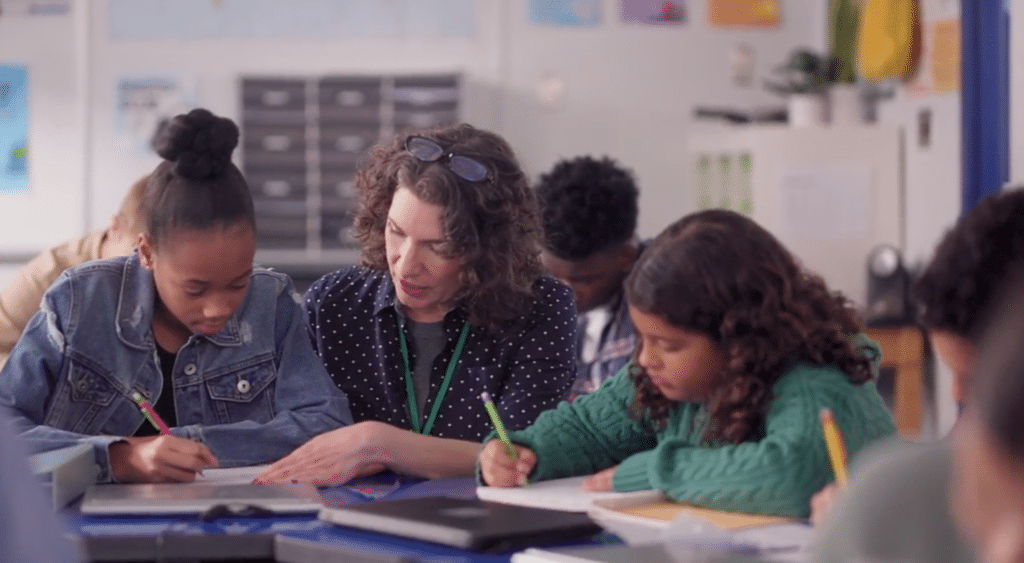What does a paraprofessional do in a school?

Considering a new job as a substitute paraeducator but not sure what the role entails? You like the idea of working with students who need additional support, but wonder what exactly does a paraprofessional do?
This guide offers a glimpse into a day of work in a school learning environment, and tips to help you confidently handle your first day on the job. Note that some schools call the role paraprofessional or parapro, but we call them paraeducator because of their role-specific expertise in education. While no two paraeducator roles are the same, this guidance will give you a big-picture idea of what to expect.
Remember your purpose.
Being a substitute paraeducator is rewarding work. Before discussing the details of a paraprofessional job description, we want to share some insights from our 2024 Substitute Educator of the Year in the paraeducator category. Lucille Zeigler sums up her experience in working with students with special needs:
“Be patient, be kind, be a listener, and love what you do. Don’t forget you are there to help the head teacher, but you’re not the teacher. So don’t try to take over the classroom.”
You are there to support the students to succeed. You don’t have to know everything, and asking for guidance or clarification is the best way to support the student(s) entrusted to you.
Now, let’s walk you through a typical day in the life of a substitute paraprofessional.
Starting your day.
Before you start your day, double-check your arrival time the night before. You may need to arrive early to monitor breakfast or help students get off buses.
- Unless you’ve been given different directions, plan on checking in at the office. The staff will make sure you know where you’re going or introduce you to the staff member who will explain more about your day.
- Before the students arrive and your duties officially begin, ask questions about your daily schedule and clarify expectations.
- Ask about the students you’ll work with, especially if your job involves one-on-one support.
As a substitute paraprofessional, you may not have access to a student’s entire Individualized Learning Plan (IEP) due to confidentiality, but the teacher should provide the basic information you need to succeed.
Being familiar with these terms before you arrive will help you understand what support your student may need:
Accommodations: like being able to move from one seat to another during class or using notes on a quiz
Modifications: such as taking breaks between activities or changing the length of an assignment or test
Behavioral plans: strategies for redirecting, reward charts, break options, etc.
IEP plans ensure each student receives the support they need to succeed in the classroom, so listen carefully and ask questions.
Where will you be working?
Ask the lead teacher or administrator about your schedule. You may move around throughout your day, moving from one of these settings to another:
- Self-contained special education classroom
- Resource room, where students come and go throughout the day
- General education classroom, where you’ll assist students with special needs
- One-on-one setting, such as taking a student to a desk in the hall to listen to them read aloud
- An area where specials like music or PE take place
- Lunchroom or playground
Ask for a written version of your schedule, especially if you’re moving around a lot. That way, you’re always where you need to be.
Find out when and where you take breaks and lunch. Relaxing and recharging for a few minutes will help you take better care of your students.
What does a paraprofessional do?
Depending on the day, you may support one student or several students with different abilities and needs.
To better understand what to expect, let’s examine some specific tasks you might perform throughout the day.
Meal times.
Depending on a student’s needs, paraeducators may be asked to provide supports during breakfast or lunch. Because this time is less structured, you may be asked to:
- Ensure a student is staying focused on eating
- Cut food for students with limited mobility
- Open packages or milk cartons for students who need help
- Assist younger students with washing their hands or face after eating
- Notify the janitor if a mess occurs
Expect the students to be curious about your presence as a substitute paraeducator. After all, you’re someone new in their world. Be friendly and introduce yourself. A quick hello can help ease a student’s nervousness.
Assist with morning routines.
After breakfast, it’s time to head to the classroom. As the school day begins, you might:
- Help students put their belongings in a cubby or unzip a coat.
- Assist with circle time, such as sitting with a specific child to redirect them if needed.
- Escort a student to the bathroom and wait for them in the hall, then walk them back to class. They may also need help with hand washing.
- Take notes to support a student.
- Help a student read directions for an assignment.
Circulate the classroom.
If you’re in a classroom, you may be asked to circulate the room while the teacher presents a whole-group lesson. During this time, watch for students who are having trouble paying attention. If you notice anyone, gently encourage them to stay focused.
You may need to redirect their attention by using a non-verbal cue. Remember to stay respectful and positive.
Attend specials.
Next, you may be asked to accompany a specific student to specials or an elective. During these times, your goal is to focus on your students’ needs and help them succeed. You may need to help them gather materials or equipment, or redirect them if they lose focus.
Set up for a science experiment.
If you work as a classroom paraprofessional, you might support the teacher by setting up projects. This could involve gathering supplies, setting up stations, and cutting out materials for students with special needs.
Note that typically paraprofessionals support a specific student in completing their work. You may need to read the directions aloud, assist with measuring, scribe their answers, or provide additional support for a single student—not the entire class.
Cover recess duty.
Paraprofessionals and teachers often team up to cover recess duty. You may be asked to supervise a specific area to ensure students follow the rules.
Safety is a top priority, so you must stay alert and communicate with other staff members if you notice any problems.
Help with small groups.
Classroom paraeducators often help small groups of students. In this case, the teacher will provide lesson plans for you.
Read through them carefully and ask questions. Then, do your best to follow the plan and keep the students engaged during your lesson. Take notes on student progress and communicate any concerns with the teacher.
Small group work may look like:
- Listening to students read aloud
- Calling out math drills and recording student answers
- Practicing specific skills to help students work toward mastery
- Giving a spelling test
Provide one-on-one assistance.
You may be asked to work one-on-one with a student on an academic or daily skills goal.
This could involve:
- Helping as a student with reading, writing, or math skills
- Pointing out the next steps on a picture board while the student practices a skill like hand washing or brushing their teeth
- Scribing or typing for a student who struggles with writing
- Providing extra assistance and accommodations during testing (such as sitting in an alternative area to take the test in a less distracting environment)
Become a substitute paraeducator with Kelly Education.
If becoming a substitute paraeducator sounds like something you’d like to do, we have an entire library of helpful articles for paras and school educators.
They include:
If you or someone you know is interested in paraprofessional or substitute teaching jobs, fill out our brief interest form, and one of our recruiters will contact you to answer your questions. We’ll also share more about opportunities to become a substitute teacher or support staff with one of our school district partners.
View Related: Article Job searching
You might like
Find your next job
Discover thousands of temporary, full-time, and remote jobs for beginning and experienced job seekers.



